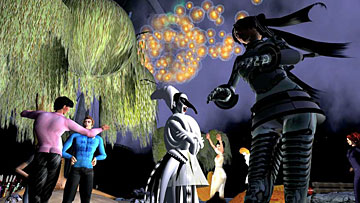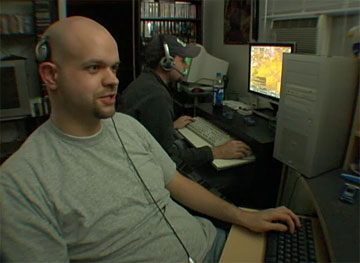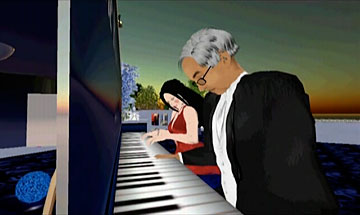
Cao Fei. Production still © Art21, Inc. 2009.
Admittedly, before beginning production research for our Season 5 segment on artist Cao Fei, I had very minimal experience with the virtual world of Second Life. “Minimal” as in: I downloaded the application a few years back, spent all of two minutes choosing my avatar’s appearance, flew around a few of the virtual environments, logged off, and never touched it again.
Among the aspects of my research was to figure out how to “film” in Second Life—an art called “machinima” to those in the know. The first person that I contacted for advice was Victor Pineiro, writer and producer of Second Skin, a documentary film about virtual worlds that was the talk of the town at its South by Southwest premiere in 2008. Second Skin employs effective use of machinima, illustrating dialogue with animations rendered from game engines. Machinima, however, is only the icing on the cake for this film.
Second Skin explores multiple aspects of the online gaming culture—including obsession, romance, family, teamwork, and fantasy. I spoke to Victor over email to discuss his experiences from the making of Second Skin. The first part of this interview below explores the relationship between the virtual world and the real world.
Jonathan Munar: A recurring theme in the work of Season 5 artist Cao Fei is this idea of taking on alternate personas that are, in part, reflections or extensions of inner fantasies. During the making of Second Skin, what did you observe about the relationship between your film’s subjects and their virtual world counterparts?
Victor Pineiro: The relationships between gamers and their avatars are as varied as the relationships between two people. Often you’ll find that the avatar is an aspirational representation of the gamer—an idealized version of the self. In some virtual worlds, like Second Life, you can modify your avatar to look exactly like you want it to, and many people try to replicate their looks, adding a bit more muscle, a bit less fat, some trendier clothes. On the other hand, sometimes a person’s avatar is merely their trophy rack, on which to hang all of the achievements and accolades they’ve garnered in the game—usually in the form of weapons and armor. For many the avatar is simply an object to gaze at—when questioned with their sexuality, many gamers who play opposite-gendered avatars reply that if they’re going to look at something for hours each day, they’d prefer it to be something they’re attracted to. And for some, the avatar is a person they can escape into—an alter ego that represents someone they’re not, but wish they could be.
Second Skin production still, 2008
JM: What sets the virtual world apart from the real world?
VP: Apart from the obvious, I think the biggest elements are anonymity and distance. Though most social internet spaces give some degree of anonymity, virtual worlds allow someone to create a visual, separate representation of themselves through which to channel their personality. In other words, virtual worlds level the playing field for anyone who might experience prejudice based on looks, weight, disability, class or race. Suddenly, someone who’s had negative social experiences for their entire life can start anew, without judgment, and be judged solely on their actions and words.
Also, virtual worlds allow for the transmission of experience over long distances. Unlike any form of communication we have developed beforehand—telephone, email, IM—virtual worlds allow you to share specific experiences with other people, no matter where they are in the world. For example, a number of soldiers stationed in Iraq jump into Second Life or World of Warcraft nightly and eat virtual dinners with their families at home. Unlike relating what’s going on over the phone, the family can enjoy each other’s company, go to a virtual park, have a virtual picnic, experience a rock concert or roller coaster together—inside a virtual world. It’s an entirely new form of communication, and the most powerful one we have. As these virtual worlds become more real, distance is going to begin to matter significantly less.

Second Skin production still, 2008
JM: Have you encountered any instances where a player’s virtual world persona carries over to the real world?
VP: Plenty of people I met while making this movie told me that they’ve learned how to be better people, or at least more social, thanks to their experiences in virtual worlds. I think what’s most fascinating is the shift in personality that happens once they’ve experienced this level playing field online—and how that then affects their real life personality and character—often for the better.
JM: Your film explores romances that started in the virtual world. What sorts of observations have you made about courtship in the virtual world, and how these relationships might extend beyond the virtual world?
VP: Some of the strongest, most beautiful relationships I’ve witnessed are couples who met in virtual worlds—and it makes sense why they share such a tight bond. Obviously they share a passion and often have something to talk about and do together. But more so, it’s in the benefits that meeting in a virtual world affords them. For one, meeting someone in a virtual world is like meeting them inside out—you get to know the core person months before you’ve even seen a picture of them, much less seen them in person. You fall in love with their personality, idiosyncrasies, character, without the real life baggage. Also, people who meet in virtual worlds quickly see each other react to conflict and stress, and get a sense for the other person under duress. That way there’s no “honeymoon’s over” moment when their significant other gets angry and goes ballistic—they’ve already seen it in the virtual world while fighting a losing battle against the dragon. It also helps that most people don’t enter virtual worlds for romantic purposes—love just surprises them.

Cao Fei. i.Mirror by China Tracy, 2007. Watch on YouTube.
JM: Second Skin primarily explores the World of Warcraft, though there is a beautiful storyline that involves Second Life. Can you speak a bit about that?
VP: Sure thing. One of the most powerful experiences we had while filming Second Skin was meeting the gamer Andrew Monkelban. Andrew is a self-proclaimed resident of the virtual world, playing games like Gaia Online and spending a lot of his time in Second Life. Andrew’s affected by Cerebral Palsy and is unable to walk or talk—his entire personality is expressed almost entirely through his index finger. Ten years ago he would have probably lived a shell of the life he lives today, thanks in no small part to virtual worlds. With his virtual character Mienai Kitsune, Andrew is able to do “normal things” and lead a successful life online. He takes a leadership role in the game, and has used virtual worlds to foster a community of friends, which has inspired him to get into creative pursuits like editing anime music videos and translating Japanese comic books. The transformative power of virtual worlds is never more evident than in Andrew’s incredible story.
JM: Why did you decide to make this film?
VP: It all started with a teacher friend of ours who got really into one of these virtual world computer games. It got to the point where he was leading a double life. He’d run home from work during lunch, ten blocks, to check out what was happening in the game. He would stay up all night and show up to class with bags under his eyes. From the outside he looked like a drug addict, but since we played the game with him from time to time, we saw the full picture. Online he was the mayor of a huge town and an important leader and personality in the game. He was renowned from one end of the (virtual) galaxy to the other. We thought this was so fascinating, we decided that we would undertake the project, as my brother and our friend had started a documentary company up the year before. We’d been looking for something to sink our teeth into, and here it was.
Second Skin trailer.
Second Skin begins a limited theatrical run on August 7 in New York, Los Angeles, Austin, and Boston, with a DVD release to follow on August 25. More information is available on the film’s official Web site.
Stay tuned next week for the second part of my interview with Victor, where we will discuss the social aspects of online platforms.




Pingback: What’s Cookin at the Art21 Blog: A Weekly Index | Art21 Blog
Pingback: El mundo que…no existe?On Virtual Worlds: An Interview with Filmmaker Victor Pineiro, Part 1 « Mis mejores zapatos
Pingback: On Virtual Worlds: An Interview with Filmmaker Victor Pineiro, Part 2 | Art21 Blog